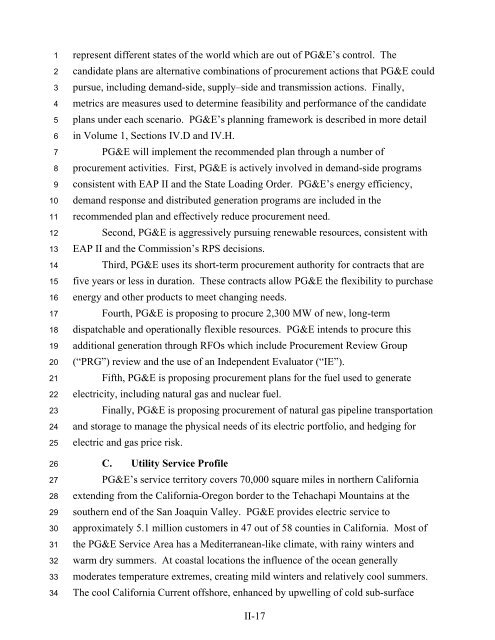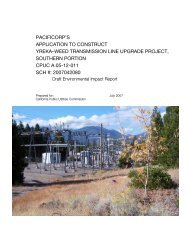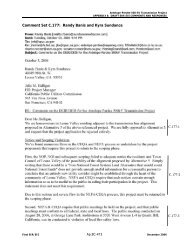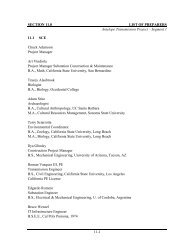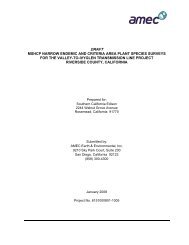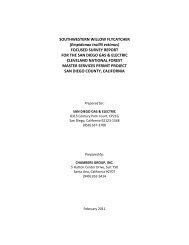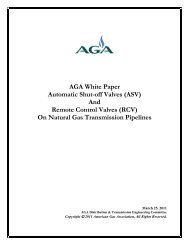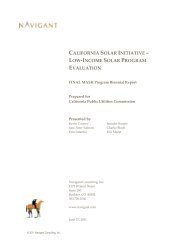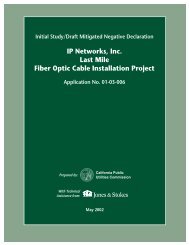Volume I. Part I - California Public Utilities Commission
Volume I. Part I - California Public Utilities Commission
Volume I. Part I - California Public Utilities Commission
Create successful ePaper yourself
Turn your PDF publications into a flip-book with our unique Google optimized e-Paper software.
1<br />
2<br />
3<br />
4<br />
5<br />
6<br />
7<br />
8<br />
9<br />
10<br />
11<br />
12<br />
13<br />
14<br />
15<br />
16<br />
17<br />
18<br />
19<br />
20<br />
21<br />
22<br />
23<br />
24<br />
25<br />
26<br />
27<br />
28<br />
29<br />
30<br />
31<br />
32<br />
33<br />
34<br />
represent different states of the world which are out of PG&E’s control. The<br />
candidate plans are alternative combinations of procurement actions that PG&E could<br />
pursue, including demand-side, supply–side and transmission actions. Finally,<br />
metrics are measures used to determine feasibility and performance of the candidate<br />
plans under each scenario. PG&E’s planning framework is described in more detail<br />
in <strong>Volume</strong> 1, Sections IV.D and IV.H.<br />
PG&E will implement the recommended plan through a number of<br />
procurement activities. First, PG&E is actively involved in demand-side programs<br />
consistent with EAP II and the State Loading Order. PG&E’s energy efficiency,<br />
demand response and distributed generation programs are included in the<br />
recommended plan and effectively reduce procurement need.<br />
Second, PG&E is aggressively pursuing renewable resources, consistent with<br />
EAP II and the <strong>Commission</strong>’s RPS decisions.<br />
Third, PG&E uses its short-term procurement authority for contracts that are<br />
five years or less in duration. These contracts allow PG&E the flexibility to purchase<br />
energy and other products to meet changing needs.<br />
Fourth, PG&E is proposing to procure 2,300 MW of new, long-term<br />
dispatchable and operationally flexible resources. PG&E intends to procure this<br />
additional generation through RFOs which include Procurement Review Group<br />
(“PRG”) review and the use of an Independent Evaluator (“IE”).<br />
Fifth, PG&E is proposing procurement plans for the fuel used to generate<br />
electricity, including natural gas and nuclear fuel.<br />
Finally, PG&E is proposing procurement of natural gas pipeline transportation<br />
and storage to manage the physical needs of its electric portfolio, and hedging for<br />
electric and gas price risk.<br />
C. Utility Service Profile<br />
PG&E’s service territory covers 70,000 square miles in northern <strong>California</strong><br />
extending from the <strong>California</strong>-Oregon border to the Tehachapi Mountains at the<br />
southern end of the San Joaquin Valley. PG&E provides electric service to<br />
approximately 5.1 million customers in 47 out of 58 counties in <strong>California</strong>. Most of<br />
the PG&E Service Area has a Mediterranean-like climate, with rainy winters and<br />
warm dry summers. At coastal locations the influence of the ocean generally<br />
moderates temperature extremes, creating mild winters and relatively cool summers.<br />
The cool <strong>California</strong> Current offshore, enhanced by upwelling of cold sub-surface<br />
II-17


